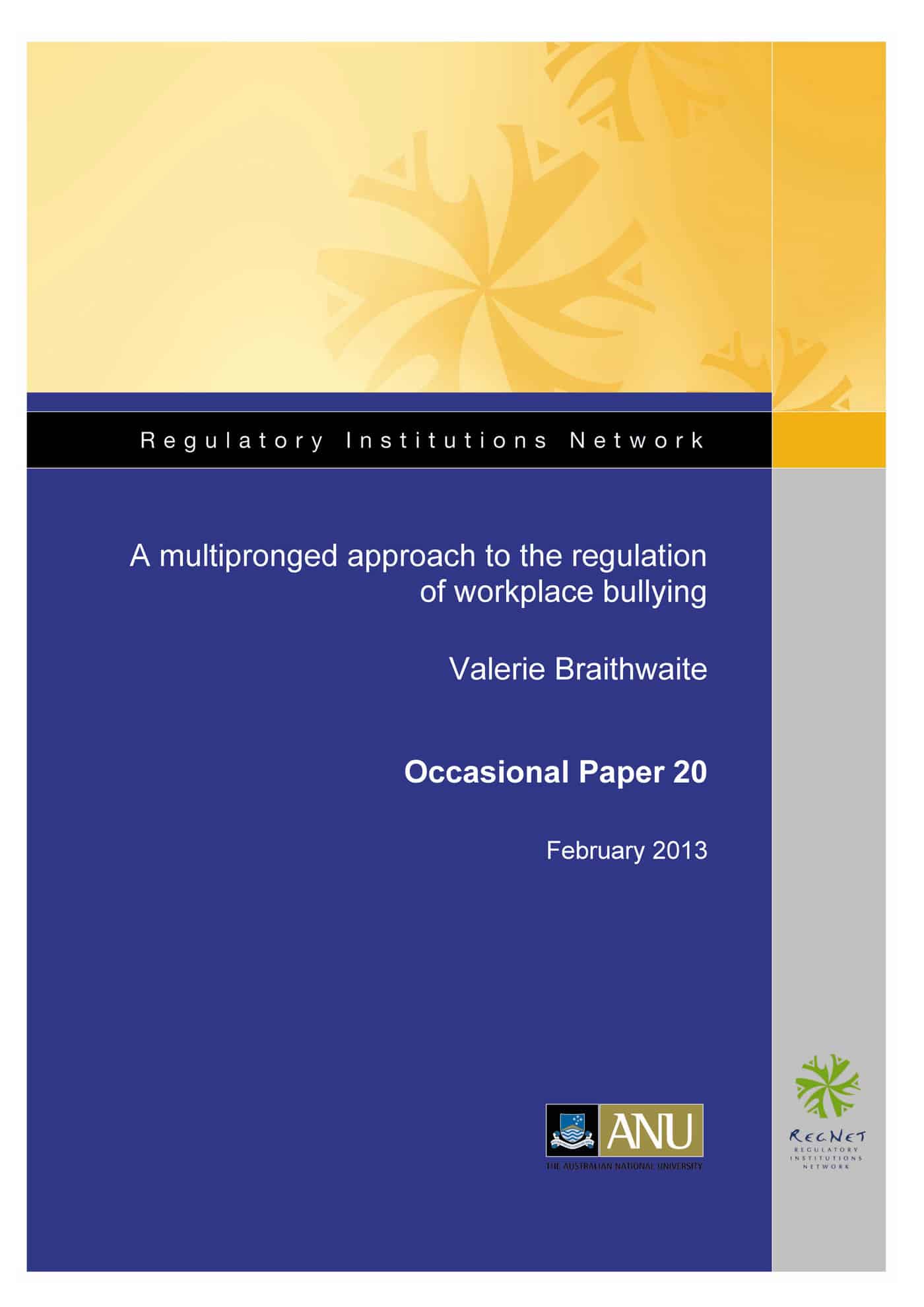 On September 9 2013, the Canberra Times published an article by Bill Eddy, entitled “Bullying a practice for the whole workplace to solve“. (The article has been tweeted and referenced several times in the past week in Australia.) Bill Eddy is due in Australia soon to conduct a workshop on workplace bullying. The article has some sound advice on workplace bullying but what caught my attention was the opening line:
On September 9 2013, the Canberra Times published an article by Bill Eddy, entitled “Bullying a practice for the whole workplace to solve“. (The article has been tweeted and referenced several times in the past week in Australia.) Bill Eddy is due in Australia soon to conduct a workshop on workplace bullying. The article has some sound advice on workplace bullying but what caught my attention was the opening line:
“Research indicates that workplace bullying has a more negative effect on employees than sexual harassment, perhaps because there are more procedures in place for dealing with sexual harassment.”
What research?
I contacted Bill Eddy through his High Conflict Institute. He appreciated my enquiry and provided the following source for his research quote -“Workplace Bullying ‘Epidemic’ Worse Than Sexual Harassment“. The source is an article from 2008 by science journalist Jeanna Bryner and based primarily on two sources – Gary Namie of the Workplace Bullying Institute and research work by Sandy Hershcovis, assistant professor of business at the University of Manitoba and Julian Barling of Queen’s University in Ontario.
Seek the evidence and verify the source
Bill Eddy provided the source of his statement but this still was not the original source. The work of Hershcovis and Barling was filtered through Bryner. I contacted Hershcovis seeking the actual research paper which Bryner had mentioned and used as part of the basis for her article, as there were no links or footnotes. Hershcovis responded and provided a copy of the research paper published in 2010 – Hershcovis, M.S., & Barling, J. (2010). Comparing victim attributions and outcomes for workplace aggression and sexual harassment. Journal of Applied Psychology. 95, 874-888. (link added)
I sent Sandy Hershcovis a link to the article Workplace Bullying ‘Epidemic’ Worse Than Sexual Harassment and she advised that
“I would not say that the outcomes of workplace aggression are “worse” than sexual harassment. The magnitude of effects are stronger for victims of workplace aggression based on the subset of consequences that I studied in this particular paper. However, there may be other unstudied outcomes that are stronger in magnitude for sexual harassment.”
There could be “other unstudied outcomes” but Bill Eddy has failed to refer to them. Clearly the research or interpretation was more complex than depicted in Bryner’s article and it has to be noted that the Bryner article appeared almost two years prior to the published research paper.
Hershcovis and Barling’s research is enlightening but, bearing in mind my suspicion of overseas research and Namie’s acknowledgement of cultural differences in workplace bullying attitudes, it is important to note that the research sample for the first study by Hershcovis and Barling (workplace aggression) was of 117 completed responses from people with a mean age of 42 and sourced through an online recruiting system at Syracuse University. In no way does this devalue the research but I believe it limits its relevance to the United States.
I believe it is important to access original material whenever one hears a statement that sounds authoritative in order to verify that authority, or provide an alternative by equally valid alternative interpretation. In a world of information that is dominated by the internet verification of data is even more important.
Cultural variations in workplace bullying research
I am always suspicious of research from one country or culture that is uncritically transposed to another. I have said elsewhere that such research can have dubious value and should be considered very carefully as economic and cultural structures vary considerably between countries. For example, the United States can be a source of very good data on occupational health and safety issues but that data principally relates to the United States where healthcare was part of one’s employment contract.
Gary Namie has acknowledged the different cultural attitudes to workplace bullying in a podcast in 2010 and reported on in SafetyAtWorkBlog at the time. Namie said how Europeans see workplace bullying as clearly under the control of the employer where America is more likely to see it as a personal issue or even a personal failing. This differentiation is crucial to remember whenever an American bullying expert comes to Australia, or Europe, as Bill Eddy is doing, or when reading any workplace bullying book written in the US.
 This “Australian” perspective is reflected in the findings Valerie Braithwaite in her February 2013 report, “A multipronged approach to the regulation of workplace bullying“, in which she found:
This “Australian” perspective is reflected in the findings Valerie Braithwaite in her February 2013 report, “A multipronged approach to the regulation of workplace bullying“, in which she found:
- “Top down approaches in dealing with workplace bullying are unlikely to be effective;
- Local knowledge, understanding and capacity are crucial to managing workplace bullying;
- Workplace bullying is an interpersonal issue that can be triggered and sustained by a host of factors including the personalities of the people involved, the norms of the workplace, structural features of the work, management style and emotional well-being;
- Workplace bullying can be understood as a competitive struggle of oneupmanship that locks individuals into bullying/victim roles;
- Better management of shame is at the heart of workplace bullying problems;
- Because of the complex set of factors leading to shame and shaping bullying, a multipronged approach is necessary that engages all levels of the organization. This might include organisational policy, organizational backing of local plans for managing bullying, mentoring, counselling, restorative justice conferencing, overhaul of work structures and practices, and mediation;
- Where workgroups communicate well, show respect for each other, are fair and open in their dealings with each other and are supported by their senior officers, compliance with policies such as anti-bullying is likely to be higher.” (links added)
Braithwaite speaks a great deal of sense. Sense that is. sadly, missing from the contemporary approach to workplace bullying in Australia. Her recommendations will be very hard to implement in the current political climate but it is hard to see a better and more sustainable strategy.
Work from the OHS evidence
OHS has rarely featured in the mainstream media unless there is a scandal attached. The journalists are largely unfamiliar with safety principles, the complexity of the duty of care or the application of the hierarchy of controls and this is a major reason for safety professionals to develop their own voice. In this way important academic, perhaps esoteric, research is provided with a real and practical context, one that allows knowledge to be applied or considered in a straightforward manner. Of course, that is if OHS research is conducted.
This communication of research was an important consideration in the development of the Australian website The Conversation which has now launched in the United Kingdom. There is a growing library of OHS related articles on the site.
I am sure that Bill Eddy’s perspective on workplace bullying will be worth hearing for what is said about the psychological cost to the individual however when discussing the responsibilities for preventing and managing workplace bullying the American perspective may conflict with the Australian corporate and regulatory system. It may be that Bill Eddy will learn more about Australian workplace bullying strategies than we will learn about the US experience.
And that is not a bad thing.

We first need to replace or get rid of the dictators at the helm, like Canada I know for one, then and only then will we rid the world of Workplace Bullying or should I say Bullying period………………..
Bill Eddy will be presenting in Victoria on the 25th and 26th September 2013 as a guest of the Institute of Mediators and Arbitrators Australia.
His topics: Workplace bullying and high risk conflict.
Beyond me why we need to bring in a Seppo to tell us how to manage our own workplaces.
Thanks for pointing this out and for doing the author\’s job for them :-).
It annoys me endlessly that overseas studies are constantly shorn of their context when reported in Aust.. either by imprecise authors or lazy journos..
Bill Eddy also low scored with me for not having done his local homework in the matter of
\”Healthy workplace laws: Some states and countries are considering healthy workplace legislation that would establish expectations for employee behaviour, and also provide for legal redress for workplace bullying\”
I suppose we are \’considering\’ additional legislation, a new national COP, the FairWork inclusion, but there is perfectly toothsome legal redress here in SA for workplace bullying, and you don\’t have to just leave (as he aslo suggests as an option) you can also report to a State Regulator who can make your workplace have to defend itself in court!
….And pyschological stress is compensable..
Better if he\’d just left the workplafe laws statement out.
The other side of failing to check local context.